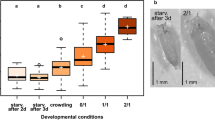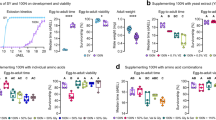Abstract
SINCE 1935, work has been proceeding on the respiration of different genotypes of Drosophila melanogaster during the first hours of the puparial period. The work has now been completed, and a full account will shortly be ready for publication, For the moment, however, it may be said that differences in oxygen uptake per mgm. body weight originally found between the sexes and between the wild-type and its mutant vestigial were later shown to be due to slight differences in the sizes of these animals ; when these were eliminated by alteration of the culture conditions the metabolic differences also disappeared. By actual measurement of the surface area of puparia it was further shown that the surface area per mgm. decreased, with increasing body size, at the same rate as did the oxygen consumption per mgm., and that the oxygen consumption was therefore related to the surface area.
This is a preview of subscription content, access via your institution
Access options
Subscribe to this journal
Receive 51 print issues and online access
$199.00 per year
only $3.90 per issue
Buy this article
- Purchase on SpringerLink
- Instant access to full article PDF
Prices may be subject to local taxes which are calculated during checkout
Similar content being viewed by others
Author information
Authors and Affiliations
Rights and permissions
About this article
Cite this article
ELLENBY, C. Relation between Body Size and Metabolism. Nature 140, 853 (1937). https://doi.org/10.1038/140853a0
Issue date:
DOI: https://doi.org/10.1038/140853a0
This article is cited by
-
A comparative study of the oxygen consumption in the three lethal mutants ?ltr?, ?lgl?, and ?lme? of drosophila melanogaster
Zeitschrift f�r Induktive Abstammungs- und Vererbungslehre (1951)



